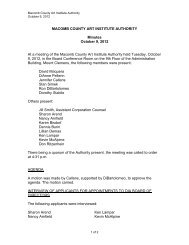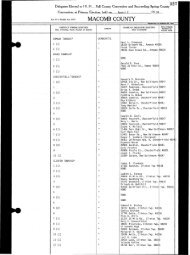The New Haven Story By Alan Naldrett The New ... - Macomb County
The New Haven Story By Alan Naldrett The New ... - Macomb County
The New Haven Story By Alan Naldrett The New ... - Macomb County
Create successful ePaper yourself
Turn your PDF publications into a flip-book with our unique Google optimized e-Paper software.
<strong>New</strong> <strong>Haven</strong> Farmers Elevator in early photo with railroad tracks in forefront and depot in the background to the left.<br />
<strong>By</strong> the dawning of the twentieth century, <strong>New</strong> <strong>Haven</strong> had electricity produced in a power<br />
house located on the north side of Ann Street (“back of Froh’s garage”) in the middle of the<br />
block. It was owned by Frank Phelps, also the owner of a Robinson Cadillac, one of the first<br />
motorcars in the village. He was given a 30 year contract on March 6, 1897, “to do all that<br />
he needed to light streets, alleys, and the grounds of the village.” <strong>The</strong> dynamo was located<br />
in the back of the building, originally called the Old Power House. In the front of the<br />
building was an ice cream parlor where sodas could be bought for a nickel. Also for sale<br />
was candy and oyster stew.<br />
Frank Phelps would use one of Thomas Edison’s inventions at the power house on Saturday<br />
nights-the motion picture projector. He would stretch a large screen between two poles and<br />
project films on to it all summer long and late into the fall. He had many reels of silent films<br />
and would use another of Mr. Edison’s inventions-the phonograph-to play music while the<br />
silent films played. <strong>The</strong> power house/ice cream parlor was the local meeting place for<br />
everyone.<br />
<strong>The</strong> power house was eventually sold to the St. Clair Edison Power Company and Frank<br />
Phelps continued as the caretaker. In 1920 they moved the dynamo to a new location at<br />
Main and Pescoe Streets. <strong>The</strong> generating plant consisted of one 2-cylinder Westinghouse<br />
gasoline engine connected to a Thompson-Houston 650-light generator. <strong>The</strong> whole<br />
operation was mechanized by Frank so that all he had to do was go in the power plant twice<br />
a day, once to turn on the lights and then again to turn them off. His ingenuity in creating the
















